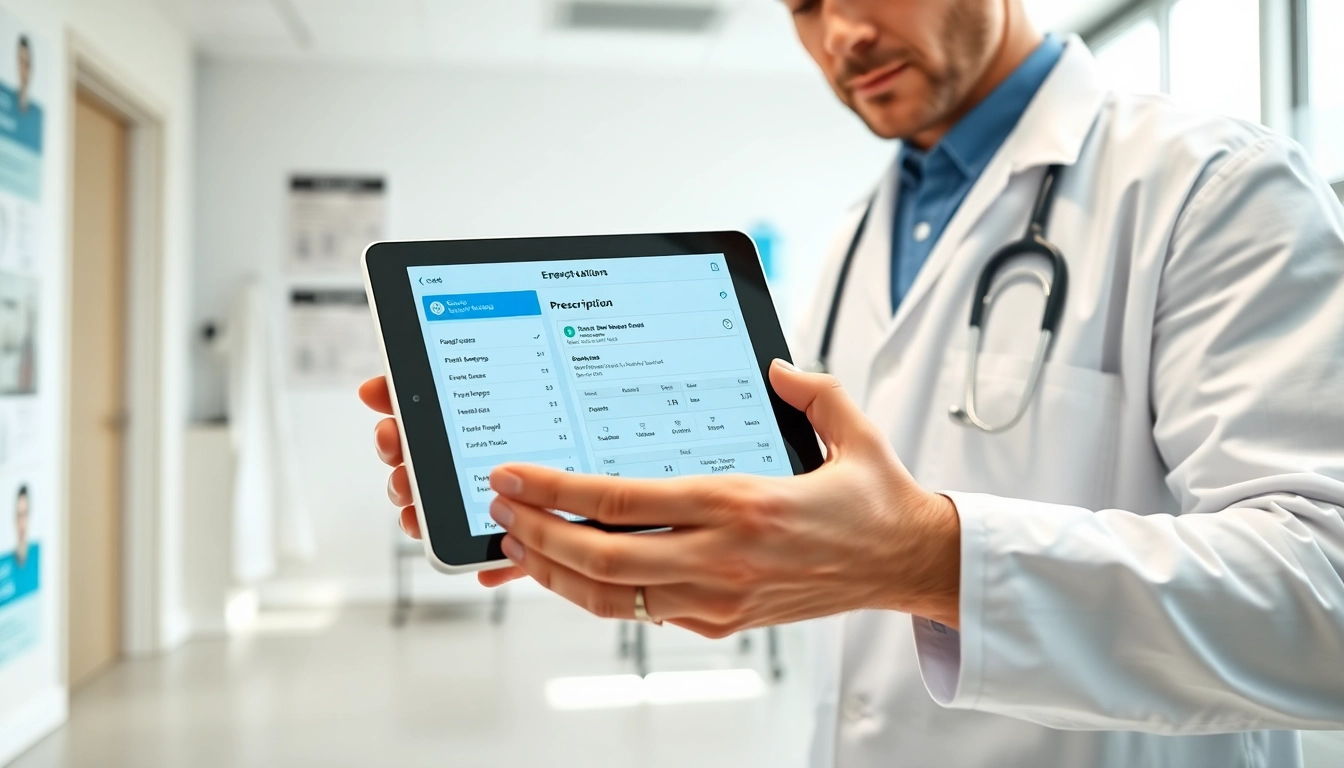Understanding Free Eprescription Apps
What Are Eprescription Apps?
Eprescription apps are digital solutions designed to simplify the prescription process for healthcare professionals. These applications facilitate the electronic creation, transmission, and management of prescriptions, replacing traditional paper-based methods. By utilizing secure technology, healthcare providers can send prescriptions directly to pharmacies, improving accuracy and efficiency while reducing the risks of errors associated with handwritten prescriptions. The integration of Eprescription apps into medical practices streamlines workflow and enhances patient care.
Benefits of Utilizing Free Eprescription Apps
The adoption of free eprescription apps brings numerous benefits to both healthcare providers and patients. First and foremost, these applications significantly reduce the time spent on prescription management. Providers can write and renew prescriptions without the need for lengthy phone calls to pharmacies, resulting in increased productivity and decreased wait times for patients.
Additionally, Eprescription apps enhance patient safety by minimizing errors. The potential for misinterpretation of handwriting is eliminated, ensuring that patients receive the correct medications at the appropriate dosages. Moreover, many apps offer built-in features such as drug interaction checks and medication history reviews, further safeguarding patient health.
Furthermore, these apps are designed to be compliant with healthcare regulations, ensuring that users adhere to necessary legal and safety standards. The ability to monitor and manage prescriptions electronically also fosters improved communication between patients, providers, and pharmacists, contributing to a safer and more seamless healthcare experience.
How Eprescription Apps Work
Eprescription apps operate through a combination of encrypted technologies and user-friendly interfaces, allowing healthcare providers to create and manage prescriptions with ease. After logging into the app, providers can enter patient information, search for medications, and select the appropriate dosage and instructions.
Once the prescription is completed, it is transmitted to the selected pharmacy via secure channels. Most Eprescription apps also allow for real-time updates and notifications, providing instant communication between the provider, patient, and pharmacy. This interoperability is crucial, as it ensures that prescriptions are filled accurately and efficiently, improving overall patient satisfaction.
Key Features to Look For in Eprescription Apps
User-Friendly Interface
A user-friendly interface is essential for any Eprescription app. Healthcare providers often have limited time and may not be tech-savvy; thus, an intuitive and straightforward design can significantly boost the app’s adoption rate. Features like easy navigation, clear labeling of functions, and the ability to save frequently used prescriptions contribute to a positive user experience.
Integration with Pharmacy Systems
Another critical feature of Eprescription apps is their integration capabilities with pharmacy systems. The ability to send prescriptions directly to pharmacies fosters communication and ensures that patients receive their medications seamlessly. An app that supports broad compatibility with various pharmacy systems maximizes its usability and effectiveness in real-world practice.
Compliance with Healthcare Regulations
Compliance with regulations such as HIPAA (Health Insurance Portability and Accountability Act) is vital for Eprescription apps. Providers must ensure that sensitive patient information is secure while using these platforms. Validated Eprescription apps adhere to stringent security standards, safeguarding patient confidentiality and minimizing the risk of data breaches.
Comparative Analysis of Free Eprescription Apps
Top Free Eprescription Apps on the Market
Several free Eprescription apps are available in the market today, each offering unique features and functionalities tailored to the needs of healthcare providers:
- iPrescribe: Known for its simple interface and ease of use, iPrescribe allows providers to prescribe medications remotely and manage prescriptions effectively.
- CharmHealth: This app focuses on providing a comprehensive suite of healthcare solutions, including Eprescribing, as long as providers see fewer than 50 patients per month.
- MDToolbox: This app specifically targets the e-prescribing needs of medical professionals, providing robust features for mobile and desktop use.
- Pabau: Pabau offers a complete practice management solution, including Eprescribing, streamlining the workflow for healthcare providers.
- Thryv: Thryv integrates Eprescribing with practice management capabilities, making it a popular choice for a comprehensive solution.
Strengths and Weaknesses of Popular Options
While each of the aforementioned apps has its strengths, they also have challenges. For instance, iPrescribe’s strength lies in its user-friendly interface, but it may lack some advanced functionalities critics often point out. On the other hand, CharmHealth offers a plethora of features but may become cumbersome for users who only need basic Eprescribing capabilities.
Similarly, MDToolbox is praised for its robust features but could be too complex for providers looking for straightforward Eprescribing solutions. Understanding the strengths and weaknesses of each app allows providers to choose the one best suited to their needs and practice size.
User Reviews and Ratings
Analyzing user reviews and ratings can provide insightful information about the practical experiences of providers using various Eprescription apps. It’s essential to look beyond overall ratings and delve into specific feedback regarding ease of use, customer support, and software stability. User feedback can serve as a vital factor in selecting the right Eprescription app.
Implementing Eprescription Apps in Your Practice
Steps for Successful Adoption
Implementing Eprescription apps in a medical practice requires careful planning and execution. Here are several key steps to ensure a smooth transition:
- Assess Your Needs: Evaluate the specific needs of your practice, including the volume of prescriptions issued and the types of medications commonly prescribed.
- Select the Right App: Based on your assessment, choose an app that aligns with your needs and workflow.
- Engage Staff: Involve your staff in the adoption process. Their feedback can be invaluable in understanding potential obstacles or features they find useful.
- Training: Provide comprehensive training for all users to ensure everyone is comfortable with the new system.
- Monitor and Evaluate: After implementation, continuously monitor the app’s performance and gather feedback for any further improvements.
Training Staff on New Technologies
Effective training is crucial in the successful implementation of Eprescription apps. Consider the following strategies for training staff:
- Organize hands-on workshops where staff can practice using the app in a controlled environment.
- Provide easily accessible resources, including video tutorials and user manuals, to aid in self-learning.
- Encourage an open forum for staff to share experiences, ask questions, and resolve issues collaboratively.
Measuring the Impact on Patient Care
Once the Eprescription app is in use, measuring its impact on patient care is vital. Key metrics to consider include the reduction in prescription errors, the time saved in processing prescriptions, and feedback from patients regarding their satisfaction with the prescription process. Gathering this data not only helps to evaluate the effectiveness of the Eprescription app but also provides insights into areas that may require further enhancement.
Trends and Future of Eprescription Apps
Emerging Technologies in Eprescription
The landscape of Eprescription apps is evolving rapidly, driven by emerging technologies. Innovations such as artificial intelligence (AI) and machine learning are increasingly being integrated into Eprescription systems. These technologies can analyze prescription patterns, assist in drug interaction checks, and even suggest alternative medications based on patient health records, enhancing both safety and efficiency in the prescribing process.
Patient Privacy and Data Security Considerations
As Eprescription apps gain traction, the importance of patient privacy and data security becomes paramount. With the rise of electronic health records, ensuring that sensitive patient information remains protected against data breaches is essential. Healthcare providers must choose apps that utilize robust security measures, including encryption, secure authentication, and regular software updates to safeguard patient data.
The Future of Digital Prescribing
The future of digital prescribing appears bright, with continual advancement in technology and increased adoption rates among healthcare providers. As telehealth and remote patient monitoring become more commonplace, Eprescription apps are likely to further integrate with other healthcare technologies, creating more comprehensive healthcare solutions. Thus, as the digital healthcare landscape evolves, the role of Eprescription apps will undoubtedly expand, yielding improved patient outcomes and enhanced operational efficiencies.



